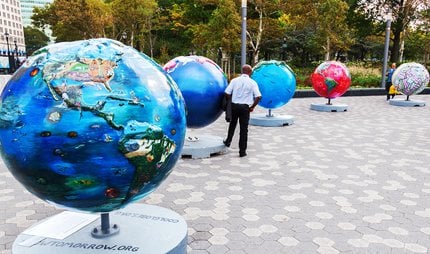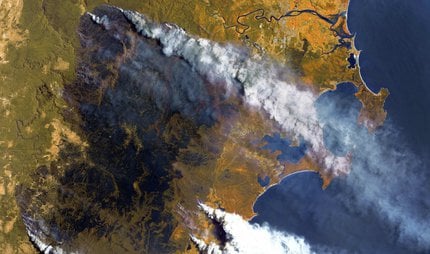What Is Global Warming?
Global warming is responsible for climate change, which is affecting many areas in the United States and around the globe. The National Aeronautics and Space Administration, better known as NASA, has compiled figures that indicate that the average global temperature has risen two full degrees Fahrenheit since 1880. At the same time, we are losing about 428 billion metric tons of ice sheets from the polar ice caps each year.
Global warming is responsible for climate change, which is affecting many areas in the United States and around the globe. The National Aeronautics and Space Administration, better known as NASA, has compiled figures that indicate that the average global temperature has risen two full degrees Fahrenheit since 1880. At the same time, we are losing about 428 billion metric tons of ice sheets from the polar ice caps each year.
Global Warming Definition
The definition of global warming may vary depending on the source. National Geographic notes that global warming consists of a "set of changes to the Earth's climate." These changes can affect long-term weather and can have different effects depending on the location being studied.
The online encyclopedia Britannica.com defines global warming as the increase in average air temperatures near the Earth's surface that has been occurring over the last 100 to 200 years. Britannica.com also links global warming to climate change, which includes a number of different weather events and is attributable to increases in greenhouse gases that are almost certainly the result of human industry and activity.
Many individuals and agencies use the terms global warming and climate change interchangeably. In fact, global warming is just one of several elements of the climate crisis that can be attributed to pollution and the increased amount of greenhouse gases trapped in the atmosphere. According to the U.S. Geological Survey, the term global warming refers only to the overall rise in global temperatures caused by the buildup of greenhouse gases. Climate change, by contrast, consists of the long-term changes in precipitation, wind patterns and temperature that are caused by these same factors.
What Is Global Warming?
In simple terms, global warming is the consistent and steady increase in average temperatures around the world and in the United States. Temperatures have fluctuated upward and downward throughout the history of the Earth. However, the temperature increases associated with global warming are more rapid and are directly connected with the pollution produced by humans.
The National Oceanic and Atmospheric Administration (NOAA) has collected figures that show an uneven but steady rise in global surface temperature since 1880. In 2019, NOAA recorded the second warmest year on record. Only 2016 was warmer on a worldwide scale. Average global temperatures in 2019 were approximately 2.07 degrees higher than those recorded in the years between 1880 and 1900. In fact, the 10 hottest years on record have all occurred between 1998 and the present. Nine of those occurred after 2005.
Individual years with higher-than-normal or lower-than-normal temperatures are a natural part of the weather cycle. Global warming, on the other hand, is a steady increase in the average temperatures that has been monitored and tracked over time. NOAA reports that more areas are growing warmer than are cooling on a worldwide level. This trend has been continuing for at least 100 years.
The Effects of Global Warming
The Natural Resources Defense Council (NRDC) has identified several important consequences of global warming:
Severe weather events are increasing in frequency and becoming worse. These include hurricanes, droughts, floods and prolonged heat waves. As the Earth warms, the atmosphere becomes capable of absorbing, holding and dropping more water, which usually results in dry areas becoming even dryer and in flooding in already wet areas. This uneven distribution of moisture can lead to increased risks of hurricanes, tornadoes and other natural disasters.
NOAA tracks weather events and the costs associated with them. According to NOAA, there have been 279 climate-related or weather disasters in which the damages and costs met or exceeded $1 billion. Overall, NOAA reports that the total cost of all of these 279 events is more than $1.825 trillion. From January 1 to October 7, 2020, 16 climate and weather disasters have occurred that cost more than $1 billion each. These include droughts, severe storms, tropical cyclones or hurricanes and one wildfire.
The U.S. Environmental Protection Agency (EPA) also attributes the increased risk of wildfires in recent years to global warming and climate change. According to figures compiled by the National Interagency Fire Center and released by the EPA, the average number of wildfires every year since 1983 is 72,000. Acreage burned by wildfires is showing a steady increase that appears to correlate with higher average global temperatures. Nine of the 10 years in which the highest number of acres were burned have occurred in the period since 2000.
Global warming has been responsible directly or indirectly for a large number of human deaths. The Centers for Disease Control and Prevention (CDC) states that an average of 702 annual heat-related deaths in the United States were reported from 2004 to 2018. The Guardian reported in June 2020 that the average number of heat-related deaths in Arizona have doubled since 2010. Additionally, between 1999 and 2016, there were more than 10,000 deaths that could be partially or wholly attributed to extreme heat.
People are not the only ones affected by global warming. According to a study published in June 2015 in the scholarly magazine Science Advances, the Earth may currently be experiencing a sixth mass extinction event involving vertebrate species. Over the last century, vertebrate species have been lost at a rate 100 times the normal and expected rate. This indicates that many species of wildlife cannot survive the changes in their environments that have resulted from global warming.
What Causes Global Warming?
According to the scientists at NASA, the greenhouse effect is responsible for most of the measured increase in global temperatures over the last 70 to 100 years. The atmospheric gases that are most responsible for the greenhouse effect include carbon dioxide, chlorofluorocarbons, methane, and nitrous oxide. Water vapor is also classed as a greenhouse gas. The moisture in the air, however, is seen as a mitigating factor that can actually respond to the presence of other greenhouse gases and may serve to lessen some of the most serious effects of greenhouse effect warming.
The greenhouse gases responsible for global warming are produced by many human activities:
- Carbon dioxide is naturally produced when animals breathe. Levels of this gas in the atmosphere can also increase when volcanos erupt, when fossil fuels are burned and when vegetation and trees are removed from the land.
- Chlorofluorocarbons are synthetic compounds that are produced when humans engage in certain industrial practices. Also referred to as CFCs, these chemicals are restricted because of their destructive effect on the ozone layer.
- Methane is produced in large quantities by animals during the digestive process. Cattle raised for beef in large herds are responsible for releasing significant amounts of methane into the atmosphere. As waste decomposes in landfills and is used as fertilizer in agricultural applications, it can also produce methane that contributes to the process of global warming.
- Nitrous oxide is usually released during the application and use of organic and commercial fertilizers. It can also be produced and released during the use of fossil fuels and when biomass is burned.
NASA attributes many of the changes in overall global temperatures to increased greenhouse gases, which are increasing the natural heat retention caused by the greenhouse effect.
What Is the Greenhouse Effect?
Essentially, the world's atmosphere can be seen as a large and complex greenhouse. The gravity of the earth is responsible for keeping air and clouds close to the surface of the planet. The sun's rays filter through the atmosphere. Light and heat from the sun are absorbed by the surface of the Earth and is then released and reflected upward as infrared heat. Greenhouse gases prevent this heat from leaving the atmosphere by trapping it and returning it once more to the surface of the earth.
When large amounts of greenhouse gases are present in the atmosphere of the Earth, not enough heat can escape. This causes a gradual but inevitable increase in the temperatures experienced in various areas of the world. Greenhouse gases play a large role in trapping heat close to the Earth's surface.
One example of a runaway greenhouse effect and its results can be found in our own solar system. NASA points to Venus as an example of what can happen when the greenhouse effect is too strong. Because only a small amount of heat can escape from its surface, the average temperature on the planetary surface of Venus is 864 degrees Fahrenheit.
Could Global Warming Be Caused by Changes in the Sun?
Almost all scientists agree that global warming is not the result of changes in the energy Earth receives from the sun. There are several pieces of evidence that disprove this theory:
- According to scientific observations, the heat and light that Earth receives from the sun have changed only slightly or have remained constant since the year 1750.
- Climate change models that do not include changes in the greenhouse effect cannot adequately account for the increases in average global temperatures.
- The changes in the atmosphere's temperature are primarily felt in the lower atmosphere. Changes in the sun's activity would affect all layers of the atmosphere equally.
This evidence has been collected and verified by NASA and by many other scientific organizations. It indicates that the process of global warming is primarily caused by the buildup of greenhouse gases in the Earth's atmosphere.
When Did Global Warming Start?
According to most scientific researchers, global warming started at least 100 years ago. A recent study published in Carbon Brief, however, puts that figure at closer to 1830. This is close to the start of the Industrial Era and may indicate that the Earth's atmosphere is far more sensitive to greenhouse gas buildup than was previously thought.
As the amount of greenhouse gases released into the atmosphere increases, the speed of global warming and the risk of extreme heat and weather events associated with this phenomenon also increase. Taking steps now to address the issue could have long-term positive effects on the livability of many areas of the Earth.
How Can We Stop Global Warming?
There are many ways in which governments and individuals can act to stop global warming. The Interamerican Association for Environmental Defense (AIDA) has identified five key areas in which governments must act to protect the environment and to halt the progress of global warming:
- Restoring ecosystems can be as simple as replanting trees or as complex as mitigating damage to fragile wetlands. Governments can designate funding for conservation and preservation of these areas to restore ecosystems that have been damaged by human intervention.
- Supporting small farms and agricultural producers who use sustainable methods to produce food is another way in which governments can promote a healthier environment. Stopping deforestation and reforming the meat industry to prevent some of the releases of methane and other greenhouse gases will also go a long way toward slowing the progress of global warming.
- Reducing our use of fossil fuels will lower the number of particulates and short-lived pollutants currently being released into the atmosphere. These chemical compounds and soot particles can play a big role in increasing the greenhouse effect.
- Taking steps to help communities in areas hardest hit by increasing temperatures is also necessary to reduce the human cost of global warming. This may include relocation of vulnerable populations or, in some cases, providing technologies to help make their communities livable again.
- Investing in green energy and converting fossil-fuel plants to wind, solar and other green-friendly power sources is one of the most important ways in which governments can slow the progress of global warming.
It may seem that individuals and families cannot do much about this major issue. In fact, making smarter choices can have a real impact on the environment. The NRDC has offered some practical suggestions for those interested in joining the fight against global warming: - The most important step you can take to combat global warming and climate change is voting with your dollar. Support sustainable businesses and businesses that follow ethical practices for the earth. The more demand there is for accountability, the more businesses will be forced to clean up their act.
- Obtaining your electricity from a company that makes renewable energy a part of their plan is a good first step toward reducing your carbon footprint. If your local utility company does not offer this service, you can contact them directly to let them know this is a priority for you.
- Adding insulation to your home can keep it cooler in summer and warmer in winter. This can not only lower your utility bills but can reduce your use of fossil fuels and the greenhouse gases they can produce.
- Fixing leaks and conserving water can also lower your personal use of electricity, which can reduce the progress of global warming. Water conservation is also important as part of an overall program to protect the environment.
- Driving a fuel-efficient vehicle or riding on public transport will play a significant role in reducing the release of greenhouse gases. This can slow global warming in a measurable way.
- Eating less meat is another good way to reduce demand for large-scale meat production plants. This will discourage deforestation and will help you and your family feel healthier over the long run.
- Contacting your local, state, and federal representatives to let them know that global warming is an important issue for you and your family will encourage them to make this issue a priority. By engaging your friends and colleagues on the subject, you can put real pressure on government agencies and elected officials to do more about this important environmental problem.
Based on the latest scientific studies, National Geographic forecasts that if nothing is done to slow the progress of global warming, the average temperatures of many U.S. cities will increase significantly. New York City is one example mentioned in the article. By 2050, studies predict that winters in New York City will resemble those in Virginia Beach, a city hundreds of miles to the south. This trend will be seen across the United States and around the world.
Acting now is the best way to prevent these significant changes. By working to mitigate some of the worst effects of global warming and climate change, we can create a brighter future for the whole world.


